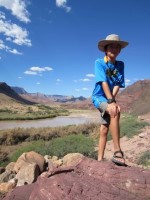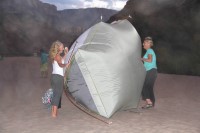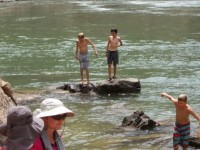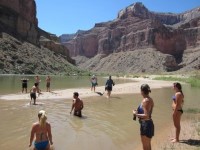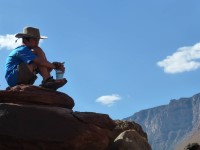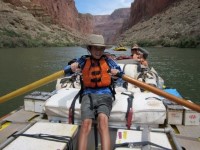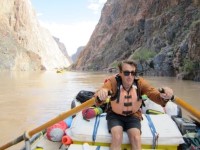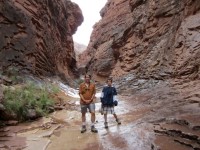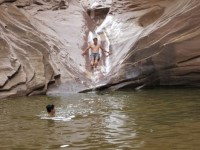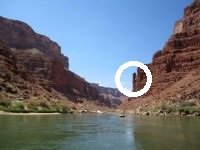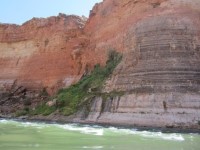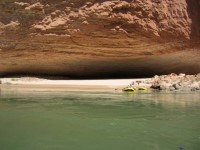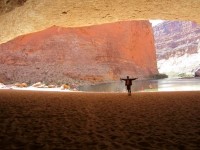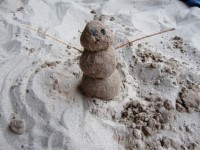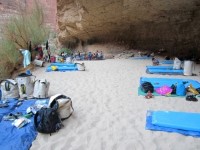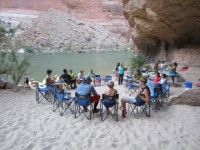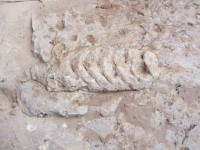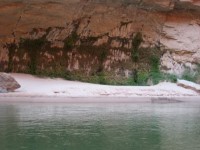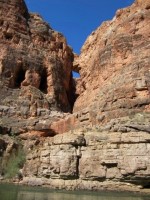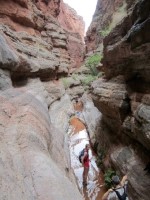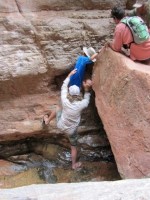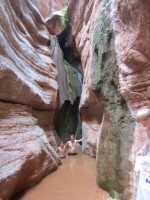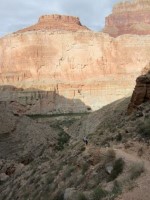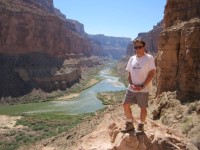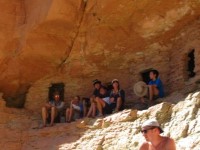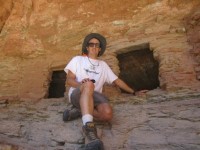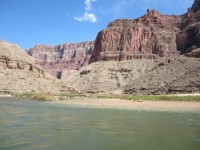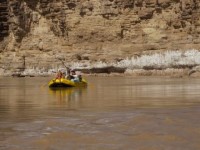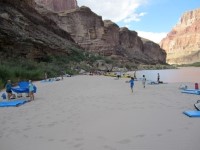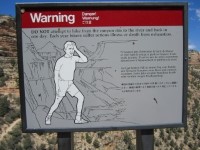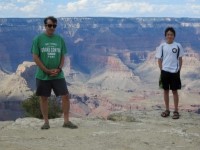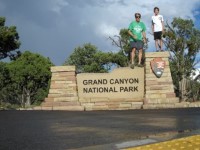Grand Canyon Rafting Trip
Introduction
On August 9, 2013, my 11-year-old son Aidan and I embarked on a six-day Colorado River trip in the Grand Canyon. This story chronicles our amazing, unforgettable trip.The Idea
I'm no stranger to the Grand Canyon. I've hiked across it three times, hiked to Havasu Falls once, visited the rim two times with the family for sightseeing, and took a helicopter trip to the west side. Still, it keeps drawing me back.It is no big secret that commercial rafting trips have been taking tourists through the Grand Canyon for decades. My mother did such a trip years ago. However, it was never officially on my to-do list until I saw a very well-done Imax movie on the Grand Canyon in Tusayan, Arizona, the tourism-based city just outside of the South Rim of Grand Canyon National Park.
The movie, in part, told the story of John Wesley Powell and included very realistic footage of some of the most exciting rapids. When I left the theater, a Grand Canyon rafting trip not only suddenly made my bucket list, but it was put near the top.
Choosing a Trip
The Park Service distributes only so many boating permits for the Grand Canyon, and the demand for a seat far exceeds the supply. Signing up a year in advance is recommended, which is what I did.There are at least a dozen commercial companies offering trips in different types of boats. There are three main types: motorized pontoon boats, dories and inflatable rafts. Most rafting companies seem to prefer the motorized pontoon boats. Here are the pros and cons of each choice, as near as I can tell:
Motorized pontoon boats: The primary benefit is they go fast. In the same amount of time as the non-motorized boats, you can cover about twice the distance. However, you have to listen to the noise of the engine the entire time on the water. The pontoon boats are also much larger and take about two to three times as many passengers per boat as the other options. They seem about as intimate as a city bus.
Dories: These are wooden boats with oars, like the kind John Wesley Powell used. They continue to be used to this day. I've never ridden in one, but I hear they offer a more exciting trip in the rapids, if that is what you want. They also need to be bailed out when they take in water.
Rafts: As I understand it, inflatable rafts offer a similar experience as the dories but are not jolted about in the rapids as much and don't require bailing. Since I had my young son with me and no legitimate experience rafting, I went with the rafts. The boats we were on held five people and all their gear comfortably.
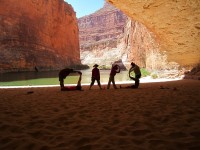
We're trying to spell "OARS."
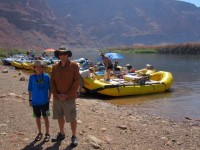
Ready to go.
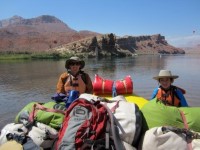
And we're off!
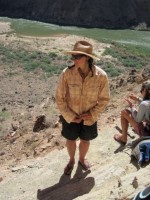
Our leader Andrea, giving a lecture
on the Puebloan Granaries.
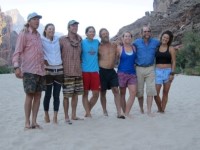
The crew.
I signed up for this trip so long ago I don't recall how I happened to stumble upon the OARS website, but they are one of the biggest river guide outfits, so it isn't surprising I found them. They break up their Grand Canyon trips into three segments. We wound up on the first one, from Lee's Ferry to Phantom Ranch. The $2,500 per person cost was not cheap.
Normally, OARS has a minimum age of 12 for this trip. At the time we did it, my son was 11 1/2. So I requested an exception to this rule. I assured OARS that he was a good swimmer and could handle the hike out of the canyon, as evidenced by a photo (ULR of picture) of both of us on the summit of Mount Whitney when he was 10. I actually prefered to do the second section of the Grand Canyon, but OARS agreed to let Aidan go only if we switched to the first portion, which has tamer rapids.
The Trip Begins
I met my fellow guests for the first time at a pre-trip meeting at 7 PM the night before in a hotel meeting room in Flagstaff. We first went around the room with introductions. Here is a brief description of the 20 guests:- Me and my son from Las Vegas
- A single teacher from Las Vegas
- A family of four from Petaluma, California
- A family of five from Buffalo, New York
- A couple from Spain
- A couple from New Zealand
- Two sisters, one from Hawaii and one from California
- A mother and daughter from Santa Barbara
Our trip leader, Andrea, went over questions regarding what to bring and made some personal recommendations that were contrary to what the OARS list suggested, which sent some guests on last-minute shopping trips. In retrospect, I think some of her suggestions were overprotective, but not everybody on the trip has the backpacking experience I do, where one learns to get by with very little and adapt given whatever they do have.
I might add that one of my heroes is Grandma Gatewood, who hiked the Appalachian Trail three times wearing Keds sneakers and carrying an army blanket, raincoat and shower curtain (used as a tent) in a homemade bag slung over her shoulder.
In addition to the packing advice, Andrea gave everybody a waterproof bag to take on the boat the first day. We were also allowed to hand carry on the boat a small backpack, which I was pleased to know. The meeting was then adjourned and we all went about packing.
We met at 7 AM the next morning, bags ready, as two vans transported us along the 126-mile journey from Flagstaff to the starting point in Lee's Ferry, just downriver of the Glen Canyon dam.
I thought the best way to organize this trip report would be to comment on various facets of the trip and then finish with day-by-day comments.
Weather
Keep in mind we did this trip in early August. This information will not be very applicable outside of July and August. Also keep in mind I have lived in Las Vegas for 12 years, so I am used to hot, dry weather.The daily temps ranged from a high of about 103 in the early afternoon to a low of 75 late at night. Although August is the rainiest month in the Grand Canyon, we only saw occasional, brief monsoonal rains in the late afternoons or early evenings. These storms lasted about ten minutes. Sometimes it would also get windy in the late afternoons, so tents should have been secured with either stakes or heavy rocks inside, lest they go bouncing down the campground like a beach ball, which happened once during our trip.
By comparison to the air temperature, the water temperature was a refreshing 48 degrees. The reason it is so much cooler than the air temperature is the water comes directly from the bottom of Lake Powell. The river water heats up one degree for every 30 miles of river.
What to Bring
It is unlikely any two people will completely agree on the answer to this question. That said, OARS provided a long list of suggested items to bring, which looked like something an overprotective mother would write. Then again, it shouldn't be surprising that the company would put safety first.It is important to keep in mind this trip was in the hot Arizona sun. The two most critical concerns are protecting the skin against sunburn and the body from dehydration. Regarding protection from sunburn, I favor covering the body with clothes rather than sunscreen. Regarding dehydration, I recommend drinking plenty of water and totally immersing oneself in the water from time to time, to lower your body temperature.
Looking back, and given the weather I encountered, here is a list of things I am the most thankful I took along:
- Wide brimmed hat.
- Backpacker's towel, to keep legs out of the sun on the raft. This is more comfortable than greasy sunscreen and not as hot as wearing long pants. A backpacker's towel, by the way, is small, light, and dries quickly. Do not use a beach or bathroom towel, as it will take too long to dry if it gets wet.
- Long-sleeved, nylon shirt. The long sleeves to keep the arms out of the sun. Nylon because it dries quickly. Our leader recommend cotton, because it stays wet longer, but I don't find it comfortable to be in soaking wet clothing, even if it is hot out.
- Bathing suit. You should be in and out of the water a lot during the day, and you will get splashed in the rapids. It is convenient to just wear a bathing suit the entire day.
- Water shoes. These shoes are meant for walking in water, like the Narrows in Zion. They are like regular shoes but made of a mesh material that drains quickly. A quality pair of sandals (not flip flops) would suffice, but we did a fair bit of hiking, and for that, the shoes are more comfortable and not as slippery.
Things I brought but didn't need.
- A rain jacket. I bought a fancy Gore-Tex rain jacket for the trip and never even touched it. The few times it rained, I was either already in my sleeping bag or it was so hot that I welcomed getting a little wet. I'm not saying don't bring a jacket, just to be safe, but any cheap rain jacket should suffice.
- Binoculars. There was always plenty to see right in plain view. Plus, on the raft, it would have been too bumpy to use them properly.
- Long pants. It was just too hot for them.
- Second water bottle. The guides were always reminding us to drink a lot, but just a single one-liter water bottle would have sufficed. A water jug for refilling was provided at every stop. The mid-trip hikes were not long enough to necessitate more than one liter of water, and the 7-mile hike out on the last day had three sources of water along the route, so a single liter of water was plenty. I'm not saying not to bring two water bottles, just in case, but I personally never needed the second one. I would also add that it is dangerous to drink too much water.
Things I wish I brought.
- Decent flashlights. We brought two cheap ones and both experienced what seemed to be overheating problems. One would go about five minutes before fading to black and the other ten. It wasn't a battery problem, because the next day they worked fine again, for the same amount of time.
- More beer. The guides transported down all the canned beverages you purchased in advance. Speaking only for myself, relaxing at the bottom of the Grand Canyon is the perfect venue to enjoy a cold beer — or three. If you bring too much, I'm sure the guides would be happy to take the extras off your hands.
- A helmet camera, like a GoPro. This is the only way to capture video of the rapids. You're supposed to be holding onto something with both hands. If you try to hold a camera with one hand anyway, don't be surprised if it, or you, ends up in the river.
- A Sharpie pen, to identify my water bags from everybody else's. The staff put some out a couple of times, but both times I thought I would wait until the rush was over, and then forgot about it.
- A few carabiners, to attach loose items, like backpacks and water bottles, to the boat.
Food
The food was simply outstanding. Granted everything tastes better when you're camping, but OARS spared no expense when it came to the vitals, especially dinner. They unpacked an entire kitchen to make meals that were much better than I am used to getting at home.It wasn't just me in our group that had a very happy tummy. One of the other guests invented a different form of "cook appreciation" every night. For example, one night it was the Chicken Dance, which I can't stand, but I went along with because the cooks truly did an outstanding job.
One litmus test I use for the quality of a restaurant is avocados, which are pricey and go bad quickly. Don't try to fool me with green paste, like some sandwich shops do. For lunch, OARS would put out the fixings for sandwiches and there were always plenty of freshly sliced avocados, still in the peels. When they made guacamole, I saw plenty of big chunks of fresh avocado.
Rapids
Being this was my first white water trip, I have nothing to compare the rapids to. To make it even more confusing, the Grand Canyon rapids are on a 1 to 10 scale while every other river in the world is on a 1 to 6 scale. Why? I have no idea. And can we please start numbering things starting with zero? Not doing so led us to the whole debate about when the current millennium started.I will say that absolutely no rafting experience is necessary for a trip like this. All you need to do is hold on tight to the ropes and let the guides worry about the rest. YouTube has hundreds of videos of Grand Canyon rapids. Here are arbitrarily chosen videos of the three most well known, to give you an idea of what to expect:
- Hance Rapid (mile 77)
- Crystal Rapid (mile 99)
- Lava Falls Rapid (mile 180). This should not be confused with Lava Canyon Rapid, at mile 65.
The only one of these I did was Hance Rapid. My trip ended 89 miles down the river at Pipe Creek Beach, just south of Phantom Ranch, where I was replaced with other guests doing the second leg of the trip. I'm told the second leg of the trip involves bigger rapids than the first.
The rapids listed above are probably the most well known because they are the most dangerous. The danger factor, I believe, comes from huge rocks in the middle of the river that the boat is in danger of crashing into. However, these are not necessarily the wettest rapids. There were lots of rapids in the "roaring twenties" that I found to be just as wavy but evidently much safer, as the guides didn't require us to put on helmets as we navigated them.
Here is pretty much all we were told to do in preparation before our first significant rapid:
- Lean forward.
- Hold onto the ropes or straps with both hands.
- Lean left or right as instructed.
- If you fall out, swim to wherever the guide points.
The entire trip I think a guide only once gave a command to lean one way or the other, but it was so noisy I couldn't hear what she said.
Rowing
During the initial meeting in Flagstaff, our leader was asked if the guests could row the boats. She said that not only was it allowed but the guides would certainly appreciate the break.During the easy stretches of the river, which is most of it, I invoked my option to row often. The way I looked at is it was a lot more fun than my rowing machine at home, and the guides indeed seemed to enjoy the rest. Whenever we got to anything technical, the guides would ask for the oars back.
Sometimes we got into spots that weren't rapids but weren't just an easy float either. Frequently, the current moved a lot faster in some parts of the river than others. The guides were experts at finding just the right places in the river to move fast — but I wasn't. Most of the purpose of the rowing, I think, was not to go faster but to maneuver into the faster currents. For this reason, experience is much more important than strength when it comes to running the Grand Canyon.
Hiking
Not counting the hike out of the Grand Canyon, we did three hikes lasting about two hours each. I'll talk about those later. There were some other, much shorter hikes too, lasting about half an hour to various points of interest in the canyon near the river.Guest Expectations
The pre-trip material said guests would be expected to help form a fire line to unload the boats upon making camp. Never once did I see such a fire line the entire trip. The only things we had to do were:- Haul our personal stuff and sleeping kits from the beach to wherever we set up camp each night.
- Properly pack and return said items in the morning after breakfast.
- Follow the procedures at the Pooperia (more on that later). This was highly emphasized.
- Wash our dinner dishes. Sometimes a staff member would even offer to do that.
Daily Camp Life
Excepting the first and last, our days followed a pretty regular routine. This is despite the frequently quoted policy that "all plans are subject to change." Here is a rough schedule:- 6:00 Announcement that coffee was ready
- 6:30 Announcement that breakfast was ready
- 7:00 Breakfast over — break down camp
- 8:00 Hit the river
- 12:00 Lunch break
- 1:30 Resume rafting
- 4:30 Make camp
- 6:00 Dinner ready
- 6:30 Finish dinner — free time
- 9:30 Go to sleep
This reads like seven hours on the river, but the average wasn't that high. Either there would be a hike break along the way, an extra-long lunch stop to include a long hike, or we made camp early. I would say the average time rafting per day was five hours.
With the free time after dinner, most guests stayed in their dinner seats drinking beer and chatting. Some went off to their sleeping bags to read or just relax on their own. Around 8:30 most nights, a staff member would play the guitar or tell a story.
One point to make with all this is that you don't need to bring much to kill the time, as the staff keeps you entertained almost all day. A single book should be all anybody needs. Over the six days, I probably spent just two hours with mine. I found the best times were those set aside when making and breaking camp, as they allowed a lot more time than I needed.
Sleeping
OARS made available a sleeping kit for $50 per guest. I noticed that every other guest invoked this option. Personally, I had planned to bring sleeping gear for Aidan and myself, but a few days before the trip, somebody with OARS said the mules used to haul up gear the day on our last day were overbooked and asked if I would mind if my extra gear was hauled up the following day and shipped to me. In return, they would let us use two sleeping kits for free. Since I wouldn't need my gear for a while anyway after the trip, I agreed.The sleeping kit included a sleeping bag, sheet and pillow. They also gave us an inflatable sleeping pad, which came pre-inflated. It was so warm at night that I started out just sleeping on top of the sleeping bag and under the sheet. However, somewhere around 2 AM, I would get chilly and crawl into the bag.
They also provided a two-person tent for every two people. However, this was not needed in our case. It wasn't cold enough to warrant one. Although August is the rainiest month in the Grand Canyon, we saw only brief monsoons from about 4:00 PM to midnight. During those rains, I was already in bed and was satisfied to take refuge in just the sleeping bag. The first night I believe every guest except me set up a tent, but by the last night, I saw zero.
Bodily Functions
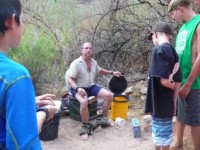
Demonstration of the Pooperia
by Jefe. Photo by Sarah
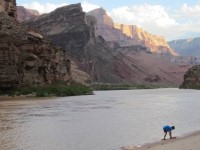
Aidan inventing a
self-flushing urinal.
Photo by Kelly.
There were two such "bathrooms" put in discrete places amongst the bushes. The path was lined with reflectors. You could assume that the facilities were occupied if the toilet paper was missing from the pump-driven hand cleaning set-up.
For urination, we were encouraged to go directly in the river, as they would dump out the urine bucket in the river anyway. As they say, "the solution to pollution is dilution." At first, the group, including me, seemed unsure about the etiquette of taking a pee with so many of the opposite sex around. However, it was usually difficult to find a discrete place to do so, because the beaches were often small and/or lined with thick vegetation or rocks.
What ended up happening a lot was something seen frequently on Survivor: enter the river up to your waist and pee. As the days went on, the men were less shy about just standing on the shore and going in the water, back turned to as many of the women as possible. If the ladies were offended by this, I couldn't tell.
Cost
The cost was not cheap: about $2,500 each. You can always go to the OARS web site and check on prices yourself. One thing you should consider is that once you get started, there is nothing to spend money on, except the gratuity at the end.Tipping
One nice thing about this kind of trip is you're not being hounded for tips right and left. As a Las Vegas resident for 12 years, I know we've taken tipping to ridiculous extremes. So it is nice to enjoy a service without wondering if and how much I should tip all day long.The pre-trip materials said that on the last day, we could give the leader a gratuity, which would get split up amongst the staff. When the last night came, I asked another guest what was the expected amount. She said she already discussed this with other guests, and the consensus was 5 to 10% of the trip's cost. The FAQs on OARS' website recommends 5-10% as well.
Day 1 or Rafting Statistics — Part 1
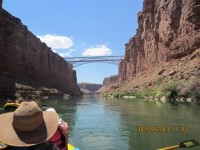
Navajo Bridges. Photo by Kelly.
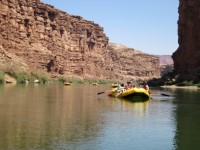
Calm waters.
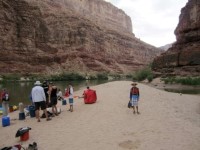
Campsite day 1.
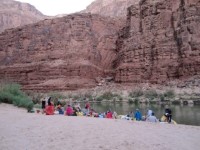
Campsite day 1.
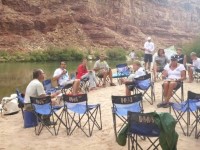
Here I am next to the couple from
Spain, subjecting them to my awful
Spanish. Photo by Sarah.
When we arrived at Lee's Ferry she said, "Congratulations, you just survived the most dangerous portion of the trip!" Pause. I didn't want to quickly get a reputation as an annoying know-it-all argumentative guest (there was plenty of time for that), so I bit my tongue. Although I didn't have statistics to disprove that claim off the top of my head, it didn't pass my smell test.
Let's take a look at some statistics now, shall we? According to the National Highway Traffic Safety Administration, there were 16,430 driver fatalities in 2011 compared to 2,946 billion miles driven. Our drive to Lee's Ferry was 126 miles. Assuming the same probability of death per mile driven, the probability of any given person dying on the drive to Lee's Ferry is 1 in 1.4 million.
Next, according to George Sayour, who writes for about.com on such things, there are 6 to 10 fatalities per 2.5 million rafting days on commercially guided trips. Let's split the difference and assume eight fatalities per year. Our trip included five full rafting days. Doing the math, the probability of any given person dying on any one day of our trip was 1 in 312,500.
So, going by these assumptions, any one day on the river was 4.5 times more dangerous than the drive to the river. I just know that the many perfectionists among my readers will nit-pick my argument. Let me save you the trouble by predicting you're going to say:
- The overall driving fatality rate is not necessarily the same for that particular stretch of road.
- The overall rafting fatality rate is not necessarily the same for the Grand Canyon.
- It is ambiguous what was meant by "part of the trip."
- Statistics compared are for two different years.
- Driver fatality rates per mile driven may not be the same as passenger fatality rates.
- Both statistics may include deaths not directly caused by the activity, for example, heart attacks.
- Fatalities are not the only measurement of "danger."
- Heaven knows what those annoying frequentist statisticians will come up with.
I'd consider these things if I had the data at hand, but I am not going to spend all day searching for finer statistics. Although some perfectionists will disagree with me vehemently about this, sometimes you just have to do the best you can with the data you have.
Now that I've lost my audience with that tirade, let me continue to talk about the trip, if anyone is still reading.
About an hour after arriving at Lee's Ferry, we were off! Our guide that day was trip leader Andrea, and Aidan and I rode with the mother and daughter from Santa Barbara. As an alumni of UCSB, I declared ours the "Santa Barbara Boat."
The first noteworthy site was the Navajo Bridge, which we had just driven over and were now floating under. It rises 470 feet above the river. We were already in what looked like a canyon, although by the time we reached Phantom Ranch five days later, the rim would be ten times higher.
The few rapids we encountered on day one were mild. Being introduced to the rapids gradually allowed beginners like me and my son to feel comfortable. To alleviate the many long stretches of calm water, the staff bought out big syringes for use in water fights. Jumping out of the raft to cool off was also encouraged.
I'm not sure, but I think we made camp at a campground known as "19.4 mile campground," which is obviously 19.4 miles down the river. It was a nice, shady spot with a sandy jetty and room for individual space behind the beach, by the cliffs.
Early in the trip, I was torturing the unfortunate couple from Spain with my awful Spanish. It is just good enough to make simple conversation, but bad enough to completely butcher the language. It turns out one of the couples from New Zealand and Mia, one of the assistants, spoke Spanish too, but they always answered me back in English, which is no fun. The perfect victim is one who knows English about as well as I know Spanish, which was the case here.
A final note about day one is a couple guests mentioned our timing was perfect for the Perseid Meteor Shower. Indeed, they were right. During our trip, I must have seen about 100 meteors, including one really bright one that spanned the entire sky. Under the clear skies of the Grand Canyon, it is was certainly the best show of meteors I've ever seen.
Day 2
Our guide on day two was Curtis and our guest companions were the sisters from Hawaii, although one of them since moved to Long Beach, California.In the morning, we went through the "roaring twenties," which were one fun splashy rapid after another, yet nothing so serious to require helmets. In terms of rafting, this was my favorite day.
For our hike, we went a little ways into North Canyon, which was one of hundreds of canyons off to the side. Our destination was a natural rock slide and pool beneath. This illustrates why I recommend wearing a bathing suit all day long.
Day two we also passed by Indian Dick. Yes, they actually call it that on the maps. Click on the link for a better picture than the one I took. We then passed by Vasey's Paradise, which is a spring pouring out the side of the canyon. These happen often when an aquifer meets a layer of impermeable rock, so the water finds its way out just above that layer.
Shortly after that, we spent some time in Redwall Cavern, which is a huge chamber with a sandy floor that John Wesley Powell said could seat 50,000 people. With all due respect to Mr. Powell, I would put the number closer to 5,000. Then again, I probably expect more leg and elbow room than he did. In fact, Powell lost his right arm in the civil war, so all the less elbow room he might expect.
I think the place we made camp at is known as "Little Redwall," just past mile 34. It was the smallest camp of the trip, but very homey. It had a sandy common space right by the beach with enough space along a ledge to individually line up our sleeping bags. Fortunately, I didn't notice anybody snoring, as we were all within earshot of each other. A good thing about this camp is you didn't have to walk far to get anywhere.
The couple from New Zealand were celebrating their 30th wedding anniversary that day, and another guest wanted to mark the occasion by singing them the theme song to the Love Boat. For once I came in handy, as I was the only person who could recall any of the lyrics. Amazingly, or perhaps not, I could remember about half of them. Keep in mind, I hadn't seen the show in about 30 years, so I hope I can be forgiven for forgetting some of them.
Those who know me would not be surprised that this opened the floodgates to Love Boat trivia questions. When it was obvious the rest of the passengers had better things to do in the eighties than watch that show, I moved on to other sitcoms from the seventies and eighties. I have trouble remembering my kids' ages, but have no trouble telling you such things as the name of Arnold's fish on Diff'rent Strokes was Abraham. Anyway, at this point I think I became known as the trivia guy.
Day 3
This day our guide was Scotty and our fellow passengers were the Santa Barbara mother and daughter again.It was a calm day on the river. At one point did a short hike to see fossils of nautiloids, which lived hundreds of millions of years ago. They were squid-like creatures about the size of a football. On another short hike we saw the ruins of an old boat and a marker where the body of an early explorer was found.
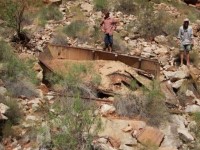 Used boat for sale — cheap. |
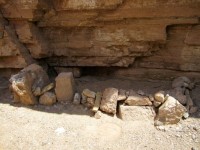 Memorial to early explorer. |
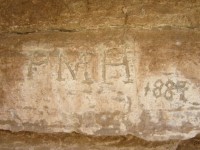 His initials were PMH. |
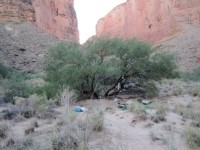 Our campsite night #3 |
If I'm not mistaken, we camped at the Upper Saddle campground between miles 47 and 48. We arrived early, so we had time to take a hike up the side canyon to a small waterfall and pool below. This campground was not very sandy or shady but had plenty of room to spread out.
Day 4
On day 4 our guide was Jefe, my favorite. He is a salty, older guide with lots of interesting stories about the canyon. Our fellow guests were the Hawaiian sisters again.In case you're wondering how it was determined who rode with whom, the guides encouraged the guests to mix it up every day so they could ride with all the guides. This was a good suggestion. Otherwise, it was first come first served. I was secretly worried nobody would want to boat with me, out of fear of being subjected to endless trivia questions and/or extremely broken Spanish, so I waited for everybody else to find a boat and my son and I would take the only remaining spots.
In the morning, we stopped in Nankoweap Canyon at mile 53 to check out the Puebloan Granaries, where Native Americans used to store seeds in chambers they made under a ledge on a steep cliff. The hike also offered a great view of the river below and good photo opportunities.
At mile 62, we came to the confluence of the Colorado River and Little Colorado River. The Little Colorado was running very muddy due to recent rains. After the two waters mixed together, the Colorado changed from a crystal green color to a muddy brown.
A couple miles after that we passed the Hopi Salt Mines, where the Indians used to walk all the way from the rim to the river to get salt. Their secret route was recently rediscovered by NAU math professor Harvey Butchart. I'm currently reading the book Grand Obsession about Harvey, based on a recommendation by one of the river guides.
Shortly after that, we saw the first sign of outside civilization we had seen since passing under the Navajo Bridge. The Desert View Watchtower was visible in the far distance on the South Rim.
We made camp early that day at a nice spot which I believe was the Crash Canyon campsite at mile 63. The big, long, sandy beach along the river was my favorite of our five campsites.
This is supposed to be a website about gambling, so I should say something on that topic. Two of the other guests were 12-year-old twin boys. I'm not sure how it got started, but I challenged one of them to a trivia bet. I bet him ten push-ups whether another guest, who I knew to be an attorney, would know who the Chief Justice of the Supreme Court was. The boy wisely asked what I know about said guest, and I truthfully disclosed that she was an attorney. He unwisely took the bet anyway. Said guest seemed to be insulted by the question, like there was even a chance she wouldn't know the answer. This led to lots more trivia gambling with push-ups until I think the rest of the guests were growing tired of it. Maybe I should feel bad about gambling with 12-year-old kids, but I prefer to look at it as a fun way to get them to exercise.
Day 5 or Rafting Statistics — Part 2
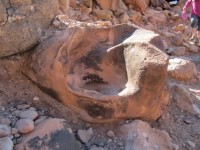
Birthing chair.
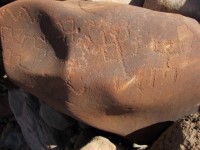
Petroglyphs.
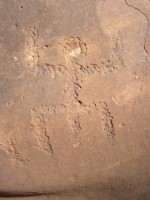
Why are the men in petroglyphs
always very well-endowed?
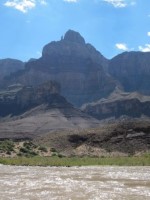
Comanche Point.
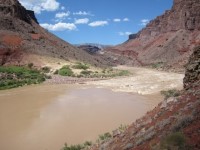
Looking down at Hance rapid.
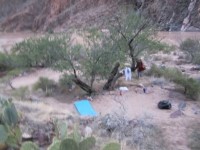
Camp day 5.
We encountered the toughest rapids that day. It was about equally as wet a day as day 2, but these rapids were rockier and thus more dangerous. At Hance Rapid (mile 77), we got out of the rafts and climbed up a cliff to observe the rapids before going through them. By the way, Hance Rapid has the largest drop in the Grand Canyon at 30 feet. However, Crystal Rapid is the one with the most deaths at six.
At this point, the guides discussed strategy; mainly, where to enter the rapids. One thing I didn't know is the rapids change year to year as flash floods move boulders and change the dynamics. Throughout the trip, the older guides were often making remarks like, "this rapid used to be much bigger/smaller." Some guides stayed back to watch the first few boats go through. We all made it through safely. This was the only time I heard a guide yell something, probably which way to lean, but the river was so noisy I couldn't discern what she said.
At this point, I was enjoying rafting so much that I was already planning to do more of it. I asked many of the guides and guests for suggested rivers. However, my wife is not a very outdoorsy person. Either I have to get her to come along or exhaust my much-needed husbanding points for such trips, which have been running low lately. It would help my odds to get her to come if I could quote some statistics about the safety of guided whitewater trips. I'm not sure if it is because she would respect the statistics or that she would rather acquiesce than listen to me spew them.
So, to be prepared, I started asking river boss Amanda for percentages on such things as passenger ejections from the boat. She absolutely would not give any such figures. Plan B was to get some data and construct the percentages myself. At this point, I asked her a lot of questions about the number of times she had run the river and the number of times she lost a passenger out of the boat. The most I could get out of her was that she ran the Colorado about 30 times and only once had a passenger fallen out of her boat.
Wanting a larger sample size, I then went into a line of questioning about the other boats on her trip. At this point, she said that she didn't want to talk about it because the river might overhear such talk and it could jinx the trip. I thought she was joking and tried to rephrase the question in a way the river wouldn't realize it was overdue to overturn a boat.
At this point she said, "If you don't stop I'm going to silence you." Ooo! I hadn't heard that term since 1989. At that time I worked for a private school in Indiana for "troubled teenagers." One of the punishments at my disposal was to put kids on silence. This meant they were not allowed to talk until taken off silence.
It is both ironic and sad that 24 years later, at the age of 48, I was on the verge of being put on silence myself. I dropped the topic of river accidents, so please forgive my lack of statistics at this point on said subject. However, I had to ask if she had ever worked for a similar program, like Outward Bound, and sure enough, she had.
After that, Amanda talked to the leaders of some other rafting companies about their camping plans for that night. We couldn't get much past Phantom Ranch because most of us were going to hike out of the canyon the next day. We would be in a jam if every remaining campsite was taken.
To make a long story short, the other raft groups were sympathetic to our problem and let us have the Lower Cremation campground between miles 87 and 88. This was similar to the spot on night 3, with plenty of space but rocky and sunny.
Here we were instructed that we would wake up an hour earlier than usual, at about 5:00, to get a jump start on the Bright Angel Trail. We were allowed to have one bag, weighing up to 30 pounds, hauled up mule, but it had to be prepared that afternoon. By the way, Aidan and my two bags weighed 7 and 14 pounds respectively. I'm not sure what the other guests brought to risk going over 30 pounds.
Some of the guides then went downriver to Phantom Ranch and back to deliver said bags. During this time, the rest of us found a shady spot by the water and relaxed drinking beer and a bottle of Scotch one of the guides kindly let us share.
All things considered, it was a hectic night compared to the others, especially for the staff. The next day was obviously going to be a logistical challenge seeing 13 departing guests up the trail to the South Rim as 13 new ones came down to replace us. The hike was supposed to be supervised, so the staff had to make sure everybody made it.
Day 6
Day 6 started out bright and early when Amanda went about camp waking people up at 5:00 AM. It was a restless night. Around midnight, my son complained that it felt like bugs were biting him all over his body, despite any such evidence, and he spilled water all over the dry clothes I was planning to wear the next day. I'm not sure in what state of sleep he was in when all this happened.At 5:00, I rushed to wake up Aidan, got packed up, and woofed down as much oatmeal as possible in a few minutes. Then we took a short boat ride to Pipe Creek, which is just downstream of Phantom Ranch. I'm told they usually drop guests off at Phantom Ranch itself, but Amanda wanted to cut down the hiking time, which this drop did by two miles. My son was very disappointed we missed Phantom Ranch, because he read a book about in school and was keenly interested, especially in the invisible scorpions that supposedly reside there. However, we have a reason to return.
The hike from the river at Pipe Creek to the South Rim is, in my opinion, one of the best hikes in America. The seven mile trek (one way) goes through various rock layers and climate zones. The bottom half is largely in the shade and much of it follows a stream. Halfway up is Indian Gardens, which is a camping area with bathrooms and water. The rest of the way up is mostly switchbacks along the steep canyon wall. This part should be preferably done before about 10 AM or after about 5 PM to avoid the blazing hot sun. Along the trail leading up from Indian Gardens are two bathrooms and water sources, at 1.5 and 3 miles from the rim.
As much as I like this hike, I should remind everybody that getting down is a lot easier than getting up. Don't attempt the whole thing unless you know you can handle the distance and elevation gain (on the way up). Also, try to time it to stay out of the direct sun as much as you can. Hiking at night, at least part of the way, is a good idea.
We reached the top in about 5 hours. Not that it was a race, but the range from our group was 4 to 6 hours. Our group of 13 met up at the Bright Angel Lodge and either enjoyed ice cream or lunch. The other seven guests, who did not do the hike, continued for the second segment of the trip on the river.
Some of us, including me and Aidan, stayed on the South Rim one night. The next day, we road the 10 AM shuttle to Flagstaff, took a cab to where I parked the car, and headed back to Vegas.





